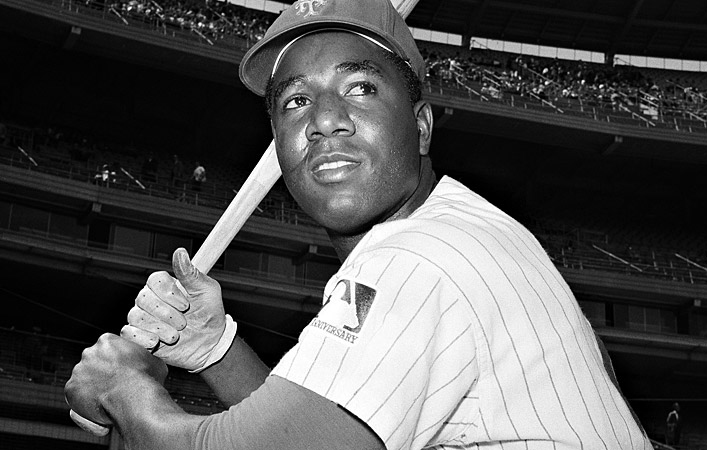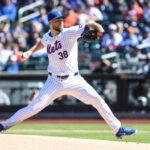
Brian Wright selects:
Statistically, some of his overall rankings in Mets history have been overshadowed mainly due to the offense-friendly eras that followed him and the era in which he played — when offense was more at a premium. Even among left fielders like Kevin McReynolds, he falls short in home runs, slugging percentage, and adjusted OPS.
But when we measure the weight of impact, this doesn’t just tip the scale in his favor — it slams it down with authority.
The 1969 season is where Jones made his biggest mark on the franchise. On a team that leaned heavily on its pitching and defense, Jones was the bat the Mets could rely on most. And more often than not, he didn’t disappoint. He batted .410 for April, hit five homers in May, and posted a June batting average of .341 as the Mets matured into contenders. This spectacular first part of the years earned him a starting spot on the All-Star team.
Injuries during the second half didn’t stop Cleon from challenging the likes of Pete Rose and Roberto Clemente for the batting crown. After hitting safely in 24 of 29 games in August, Jones was leading the NL in batting as late as early September, only for cracked ribs to slow his chase and leave him five points shy of Clemente and eight behind Rose at season’s end. However, his .340 mark would go unmatched by any Met until John Olerud surpassed it 29 years later. Jones also led the ’69 team in on-base percentage at .422, was second in RBIs (one short of Tommie Agee), and finished seventh in the Most Valuable Player voting.
But Cleon was by no means a one-dimensional contributor to the “Miracle Mets.” Among all NL outfielders, his .991 fielding percentage ranked second while his range factor was the best.
Any ailments Jones was nursing late in the regular season did not play a factor during the playoffs. He went 3-for-5 with a homer in Game 2 and tallied two more hits in four at-bats in the clinching Game 3. Cleon hit under .200 in the World Series, but was supported by the hitting heroics of Donn Clendenon and Al Weis. Jones was by no means invisible in the victory over Baltimore, as his series-ending catch of Davey Johnson‘s fly ball on the left-field warning track at Shea Stadium remains an indelible image.
Four years later, Jones was key to another pennant chase. This time overcoming a nagging knee injury, Jones belted six home runs and 14 RBIs over the final two weeks of the regular season as the Mets emerged from a crowded six-team scramble with the division crown.
When his career in New York ended during the 1975 season, Cleon had produced more hits, more home runs, more RBIs, and a better offensive WAR than any other Met. He may not have been as consistently productive as others in team history, but the crucial role he had in helping to bring this franchise two pennants and a world championship can’t be overstated.

Matt Musico selects:
Kevin McReynolds
So, I have the unfortunate pleasure of arguing against Cleon Jones being the best left fielder in Mets history. That’s a tough battle to fight, but I’ll give it a try anyways.
While I did think about following the way of a recent MMO Roundtable and tab Yoenis Cespedes with these honors, I decided to go for the very well-known Kevin McReynolds.
There are likely many Mets fans my age and younger thinking….who? After beginning his career with the San Diego Padres, McReynolds spent five productive years with the Mets between 1987 and 1991.
He was the picture of consistency at the plate, hitting 20-plus home runs, collecting 80-plus RBI, and scoring 70-plus runs in four straight seasons before falling short in each category in 1991. He also added three years of at least 14 stolen bases, and his year-to-year fWAR progression wasn’t too shabby: 2.2, 4.0, 3.4, 3.6, and 1.3.
When we head over to FanGraphs and look at the players who have graced left field during the history of the Mets, Jones’ name is leading at the top with 18.1 fWAR. However, you’ll see McReynolds right beneath him with 15.1 of his own. Jones does also come out on top in runs scored (563 to 405), RBI (521 to 456), and stolen bases (91 to 67), but Jones also played 414 more games in a Mets uniform than his counterpart did.
McReynolds actually has the edge on Jones in homers (122 to 93), walk rate (8.2% to 7.6%), strikeout rate (14.6% to 10.6%), and wRC+ (120 to 112). While these two did play in different eras, wRC+ is league and park adjusted, which makes it easier for us to look at those numbers specifically.
It’s tough to compare these two because their sample sizes are so different – McReynolds donned the orange and blue for five years, while Jones did so for parts of 12 seasons. Jones had the greater peak in Flushing (6.3 fWAR in ’69 and 4.6 in ’71), but if we purely look at the number of years he produced 2.0 or more fWAR (five times), McReynolds nearly caught him (four times).
Being a critical part of a world championship team boosts Jones’ stock significantly in this conversation, especially since that’s when he had the best year of his career and McReynolds didn’t leave Queens with a ring. However, he was one of the best players on a 1988 squad that had the talent to achieve October glory and even finished third in NL MVP voting that year.
Is Kevin McReynolds the best left fielder in Mets history? It’s tough to go against Cleon Jones, but when looking at pure opportunity and the production that resulted from it, this should be much more of a discussion than it’d seem at first glance.















